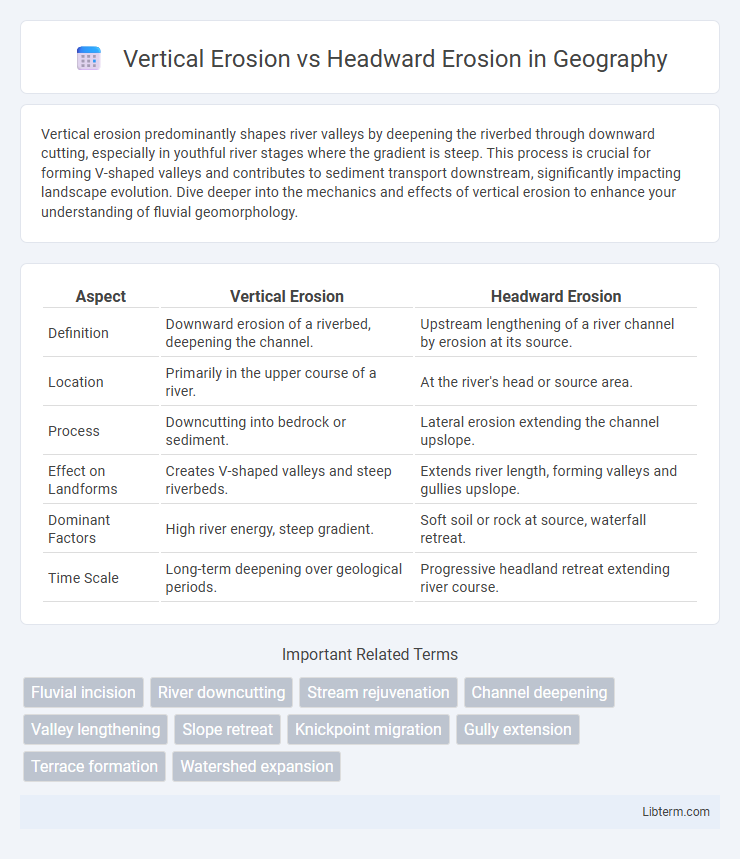Vertical erosion predominantly shapes river valleys by deepening the riverbed through downward cutting, especially in youthful river stages where the gradient is steep. This process is crucial for forming V-shaped valleys and contributes to sediment transport downstream, significantly impacting landscape evolution. Dive deeper into the mechanics and effects of vertical erosion to enhance your understanding of fluvial geomorphology.
Table of Comparison
| Aspect | Vertical Erosion | Headward Erosion |
|---|---|---|
| Definition | Downward erosion of a riverbed, deepening the channel. | Upstream lengthening of a river channel by erosion at its source. |
| Location | Primarily in the upper course of a river. | At the river's head or source area. |
| Process | Downcutting into bedrock or sediment. | Lateral erosion extending the channel upslope. |
| Effect on Landforms | Creates V-shaped valleys and steep riverbeds. | Extends river length, forming valleys and gullies upslope. |
| Dominant Factors | High river energy, steep gradient. | Soft soil or rock at source, waterfall retreat. |
| Time Scale | Long-term deepening over geological periods. | Progressive headland retreat extending river course. |
Introduction to Vertical and Headward Erosion
Vertical erosion primarily deepens river valleys by removing soil and rock along the riverbed, intensifying downcutting processes and increasing channel depth. Headward erosion extends the length of a stream or river channel by eroding sediment at the origin or upstream end, promoting the upstream migration of the watershed boundary. Both erosion types play critical roles in shaping landforms, influencing drainage patterns, and modifying landscape evolution.
Defining Vertical Erosion
Vertical erosion refers to the downward cutting action of a river or stream that deepens its channel, primarily occurring in the upper course of a river where the gradient is steep. It results in the formation of V-shaped valleys and deep riverbeds by removing sediment and rock vertically toward the base level, often at the sea or lake level. Vertical erosion contrasts with headward erosion, which extends the river channel lengthwise by eroding upstream.
Understanding Headward Erosion
Headward erosion occurs at the origin or the upper end of a stream channel, causing the channel to lengthen by eroding soil and rock upstream. This process significantly influences watershed development, extending the drainage basin over time. Unlike vertical erosion, which deepens the riverbed, headward erosion primarily expands the river network laterally and upstream.
Key Differences Between Vertical and Headward Erosion
Vertical erosion primarily deepens river channels by downward cutting into the bedrock, whereas headward erosion extends the river channel lengthwise upstream. Vertical erosion dominates in youthful river stages with steep gradients, promoting valley deepening, while headward erosion occurs at the river source, lengthening the drainage basin over time. These key differences influence river development, sediment transport, and landscape evolution patterns.
Geological Processes Behind Vertical Erosion
Vertical erosion primarily occurs when a river cuts downward into the bedrock, deepening the river valley through processes such as hydraulic action, abrasion, and solution, driven by the river's gravitational energy. The geological processes behind vertical erosion involve the detachment and removal of bedrock particles from the riverbed, aided by sediment load acting as abrasive tools that wear away underlying materials. This erosion pattern contrasts with headward erosion, which extends the river channel upstream by lengthening the valley through the weakening and collapse of bank materials.
Mechanisms of Headward Erosion in River Systems
Headward erosion occurs as flowing water erodes sediment and rock at the source of a stream, extending the channel upstream and increasing its length. This process primarily involves hydraulic action, where the force of water dislodges materials, and abrasion, where sediments carried by the flow scour the bedrock, gradually deepening and lengthening the valley. Unlike vertical erosion, which mainly deepens the riverbed, headward erosion actively carves the landscape upstream, contributing to watershed expansion and network development in river systems.
Impact of Vertical Erosion on River Valley Formation
Vertical erosion primarily deepens river valleys by cutting downward into the riverbed, increasing the valley's depth and steepness. This process intensifies the formation of V-shaped valleys, contributing to more defined and narrower valley profiles. Compared to headward erosion, vertical erosion significantly shapes the river's longitudinal profile and influences sediment transport downstream.
Role of Headward Erosion in Stream Capture
Headward erosion plays a critical role in stream capture by extending a stream channel upstream, often breaching divides and diverting flow from neighboring drainage basins. This process enhances the stream's drainage network and can significantly alter watershed boundaries, impacting sediment transport and hydrological patterns. Vertical erosion primarily deepens the river valley, but headward erosion drives lateral expansion and captures tributaries, reshaping the landscape over geological timescales.
Environmental Factors Influencing Both Erosion Types
Environmental factors such as rock type, vegetation cover, and precipitation intensity significantly impact both vertical erosion and headward erosion rates. Softer, less consolidated rock and minimal vegetation accelerate vertical erosion by allowing deeper incision, while heavy rainfall increases runoff that intensifies headward erosion, promoting upstream channel extension. Topography and soil saturation levels also influence the dominance of one erosion type over the other by altering water velocity and sediment transport capacity.
Comparing Effects on Landscape Evolution
Vertical erosion primarily deepens river channels, creating steep valleys and increasing relief by cutting downward into the bedrock. Headward erosion extends the length of a stream by eroding upstream, resulting in the expansion of drainage basins and network complexity. Together, these processes drive landscape evolution by reshaping topography--vertical erosion influencing valley depth and gradient, while headward erosion promotes watershed expansion and landform dissection.
Vertical Erosion Infographic

 libterm.com
libterm.com